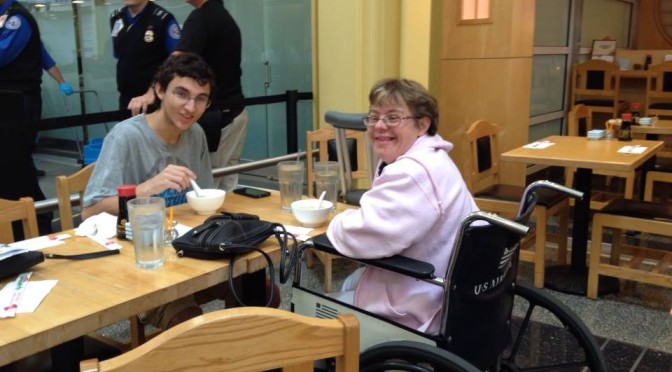Disability etiquette or disability courtesy are just plain good manners!

Disability etiquette, disability courtesy and just plain old good manners are the same thing!
Many people think that there are special rules, so they avoid interacting with people with disabilities because of their own awkward feelings.
Disability courtesy is not a set of secret rules. A great rule of thumb is, if you would politely say it to your granny, it’s OK. Polite is polite.
Quick list of specific disability courtesy tips.
Courtesy Tips for Interactions with Anyone
-
Always speak directly to a person who has a disability, rather than trough a companion who might be with them.
- Always ask first before helping someone with a disability.
- Some people will appreciate that you asked, others might be offended.
- Listen to any instructions before you act.
- Always remember to offer to shake hands.
- Wait for them to extend a hand first or let them offer another option. Be gentle. we never know someone’s level of hidden physical pain or limited mobility.
- Be patient! Let the person set the pace in walking or talking.
- Be considerate of any extra time it might take for the person who has a disability to get things done.
- Relax! Don’t feel embarrassed if you happen to say a common expression like “I’ll see you later” or “I’ve got to run.” Those are normal parts of speech.
- Don’t patronize!
- When planning an event involving persons with disabilities, consider their needs ahead of time.
- If there is an insurmountable barrier, let them know prior to the event.
- For example, “Uncle Bob, the steps to the top of the hill where Kitty and Bobby are getting married are pretty steep. We are going to set up a video feed where, if you like, you may watch the wedding in the air conditioned reception building.”
Courtesy Tips for Interacting with Wheelchair Users
-
Someone using a wheelchair is not “wheelchair bound.” The wheelchair is a mobility device. Different people have different levels of mobility.
-
Leaning on a person’s wheelchair is like leaning on a person. A wheelchair is an extension of personal space. Respect it!
- Treat adults like adults.
- Don’t patronize someone by patting them on the head. They are not a dog!
- You wouldn’t grab someone’s leg without asking, so don’t touch someone’s wheelchair without first asking and receiving permission.
- After a few minutes of conversation, put yourself on the same level as a person in a wheelchair. It will spare both of your from a stiff neck!
- You won’t stand while holding a long conversation with someone seated, so think of it the same way when you are speaking to someone seated in a wheelchair.
- When giving directions to someone using a wheelchair, think ahead of the shortest path and any obstacles that might be in their way.
- “I believe the park restrooms are about 200 yards ahead and they you will to turn left for about 100 feet to reach the ramp on the right side of the restroom building. I believe that there are steps to the left.”
Courtesy Tips for Interacting with People Who are Vision Impaired
- Always identify yourself when speaking with a person with a vision impairment.
- Example: “Hi Bob, it’s Lola.”
- Always identify who you are with.
- Example: “Hi Bob, I have my son Bubba with me to my right, Aunt Hilda is to my left with her poodle Sweetie Pie.”
- When speaking in a group, always mention the person’s name when speaking directly to them.
- Example: “Bob, are you joining us on the balcony?”
- Always let the person with a vision impairment know when you are leaving the room.
- Example: “Bob, I am heading to the kitchen, can I bring you a glass of tea?”
- Always let the person with a vision impairment know when the conversation is over.
- Example: “Bob, it was great talking with you, I need to leave now. Is there anything else you need from me? “
- Always speak in a normal tone and volume. People do not hear with their eyes!
- Offer a person with vision impairment your arm. Talk about where you are going.
- Example: “We have 2 steps down about five feet ahead” or “this sidewalk sure has a lot of cracks.”
- Do not propel or lead them. Just gently be their guide.
- When giving directions to a person who has a visual impairment, use distances and describe the path.
- Example: ” The hot dog cart is 200 yards directly ahead on the right. There sure are a lot of kids riding their bikes on the sidewalk today.”
Courtesy Tips for Interacting with People Who are Hearing Impaired
- It’s OK to gently tap a person with a hearing impairment to get their attention.
- Do not startle someone by tapping them from behind.
- It’s OK to wave your hand to get a person with a hearing impairments attention.
- Never ask “do you read lips?”
- When speaking, look directly at a person who has a hearing disability.
- The average person reading lips will only understand about 25 percent of the conversation. Follow-up with e-mail, when possible.
- If you have a friend, family member or co-worker who used American Sign Language, consider learning some basic sign language.
- Speak slowly (at a normal pace), clearly and expressively to determine if the person reads lips. Many hearing impaired people have some level of hearing. Sometimes hearing loss may affect they way they hear volume, certain letters, tones of sound or pitches of sound.
- Not everyone with hearing loss reads lips. They might rely on your expressions and your body language to understand the tone or direction of the conversation.
- Don’t shout! It just makes you look crazy!
- Ask the person if they would like you to write down what you are saying. Write clearly.
- Be considerate by facing a light source. No one can read lips in the dark!
- If you are dining, keep food and drinks away from your mouth when you are speaking.
- Keep your mustaches well-trimmed, if you need to speak with a person with a hearing impairment.
Courtesy Tips for Communicating With People Who have a Speech Impairment
- Give your whole, unhurried attention when speaking with someone who has a speech impairment or difficulty speaking.
- Keep your manner calm and encouraging rather than correcting.
- Be patient! Do not speak for the person.
- It’s OK to clarify what the person said by asking a question they can answer with a simple nod of the head.
- Example: “Oscar, you would like a large glass of orange juice. Is that right?”
- Never pretend to understand. Always ask. Repeat what you understand.
- Example: “Oscar, do you want to go to the store now or later this afternoon?” The person’s reaction will guide you.
Common courtesy goes a long way when speaking with anyone. Disability courtesy is simply treating people the way that you would want to be treated. Remember that your body language, tone, facial expressions, hand and arm motions are all observed. People know the difference between polite and rude! It’s important to remember that a person with a special need is a person first. Communicate with them as you would communicate with anyone else. If you are unsure what to do, simply ask them. Disability Smart Solutions knows that fixing buildings and public spaces to meet the everyday challenges of people living with a disability is simply meeting ADA Code and spending the money to make the improvements. We know that lives are changed when people learn how to extend courtesy to people with disability. Disability Smart Solutions offers employee training programs that teach Disability Etiquette. Great customer service is the heart of a business. We also have speakers available for schools and community groups.
We are team builders. Disability Smart Solutions has the knowledge, innovation, imagination and collaborative partners to create successful inclusive solutions. Please contact us to enhance your employee and customer engagement with both the aging and disabled populations.
407-310-3663
Disability Smart Solutions for Your Business: ADA Inspection and Accessibility Surveys
-
Inspect your building for ADA violations
-
Recommend the changes that need to be made
-
Recommend how to make the changes
-
Review the completed changes to make sure that they are completed correctly
-
Enhance the customer experience
-
Train your key people
-
Limit your exposure to ADA lawsuits
